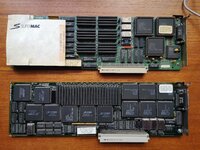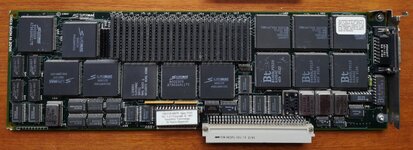-
Updated 2023-07-12: Hello, Guest! Welcome back, and be sure to check out this follow-up post about our outage a week or so ago.
You are using an out of date browser. It may not display this or other websites correctly.
You should upgrade or use an alternative browser.
You should upgrade or use an alternative browser.
SuperMac Spectrum/24 Project
- Thread starter Trash80toHP_Mini
- Start date
Phipli
Well-known member
I'll get back to you on that, its on my todo listYes - overkill. Haha! It's a nice product, but it should have 5V capability and a frequency selector.
MacOSMonkey
Well-known member
I got the 40 & 50Mhz for $1 each. It would be nice to have a mini-LCD with an intuitive selector - maybe 3 digits and an M/K, etc.
Phipli
Well-known member
These exist, but I don't know how usable they are in terms of quality, cable lengths etc :I got the 40 & 50Mhz for $1 each. It would be nice to have a mini-LCD with an intuitive selector - maybe 3 digits and an M/K, etc.

DC4.5V-5.5V 35mhz-4000mhz ADF4351-VFO LCD Display Clock Source Signal Generator | eBay
Find many great new & used options and get the best deals for DC4.5V-5.5V 35mhz-4000mhz ADF4351-VFO LCD Display Clock Source Signal Generator at the best online prices at eBay! Free delivery for many products.
www.ebay.co.uk
$1 is good going for small quantities! All my local wholesalers seem to have £20 minimum orders for free postage these days so I end up paying inflated prices on ebay.
Trash80toHP_Mini
NIGHT STALKER
@MacOSMonkey nice finds in the box rummage session! Are SuperMac and Seiko 16" resolutions 60Hz SVGA?
@Melkhior have you got anything on that subject or general observations on this insanity?
Interesting, is Video Driver Interface part of baseline Slot Manager/NuBus or the extended NuBus90 spec?Early SuperMac cards, like Spectrum/24 1.0 implemented minimal slot manager support. In later SuperMac boards, there was the addition of "VDI" (Video Driver Interface) support, which theoretically allowed for certain additional/external configurability in conjunction with SuperVideo 3.0. However, the support also had to be in the firmware, and the earlier boards absolutely did not include it.
@Melkhior have you got anything on that subject or general observations on this insanity?
MacOSMonkey
Well-known member
I messed around with my Spectrum/8 Series II board a little this weekend and made a bunch of custom configs with SuperVideo. They didn't do anything -- it was just for testing. I have to wait until the oscillators show up. And yes, I think they are SVGA-ish. The Apple 15" monitor I have has 2 800x600 SVGA configs.
Per the Spectrum manual, I verified the cut-off for the clock divider for the TMS34061 on those early boards. As noted in the spectrum manual, the mid-range values (16Mhz+) are /8 by default and, at 52Mhz+, they are /16.
I looked at the 'cnfs' resources to match up the custom timing values with the resource data structure, and the divider bit is the first word. Referring to the TMS34061 manual, it maps to the low-order nybble of CR1. So, the default value for mid-range display updates is 0x07 or 0b00000111 (n+1, or updating every 8 clock periods)...or, for faster clocks, it is 0x0f or 0b00001111 (with the extra divider bit, n+1, or updating every 16 clock periods).
By the way, if you want to reset SuperVideo to no stored configs, just delete the 'cnfs' id 29000-range resources (or copy a new version of SuperVideo into your Control Panels folder).
The main thing about the above info is that, if you are trying to create a custom config within the capabilities of the board, don't forget to divide the H vidclk values by either 8 or 16 (or multiply the pixel clock time), depending on the custom frequency you are trying to use.
Per the Spectrum manual, I verified the cut-off for the clock divider for the TMS34061 on those early boards. As noted in the spectrum manual, the mid-range values (16Mhz+) are /8 by default and, at 52Mhz+, they are /16.
I looked at the 'cnfs' resources to match up the custom timing values with the resource data structure, and the divider bit is the first word. Referring to the TMS34061 manual, it maps to the low-order nybble of CR1. So, the default value for mid-range display updates is 0x07 or 0b00000111 (n+1, or updating every 8 clock periods)...or, for faster clocks, it is 0x0f or 0b00001111 (with the extra divider bit, n+1, or updating every 16 clock periods).
By the way, if you want to reset SuperVideo to no stored configs, just delete the 'cnfs' id 29000-range resources (or copy a new version of SuperVideo into your Control Panels folder).
The main thing about the above info is that, if you are trying to create a custom config within the capabilities of the board, don't forget to divide the H vidclk values by either 8 or 16 (or multiply the pixel clock time), depending on the custom frequency you are trying to use.
If "Video Driver Interface" is something specific in that name, no. However, the video driver routines required are sometimes referred to as the "video driver software interface" (DCDMF3 p147). They did evolve over time; while the basic functions are the same, the numbers of selectors grew over time. The new ones, which I have seen called in 7.5.3 and 8.1 but not 7.1.1, includes cscSetDefaultMode, cscSwitchMode or cscSavePreferredConfiguration. There was a cscSetMode previously. IIRC, cscSetMode select among video resources where cscSwitchMode is meant to be more flexible - but I'm not 100% sure, as I didn't implement resolution switching, only depth switching, and for me both are pretty much the same.Melkhior have you got anything on that subject or general observations on this insanity?
Trash80toHP_Mini
NIGHT STALKER
Thanks much for the quick response and reference. Looks like it's back to the Technical Tomes for me while I work at getting the test setup put together.
MacOSMonkey
Well-known member
Early SuperMac boards supported a minimal-to-moderate set of control and status calls. And, as with any product line, there were various issues and bugs that improved/resolved over time, along with expanded features, control/status support and OS compatibility (i.e. A/UX). SuperMac's later feature add-on for its vendor-specific implementation of "VDI" (from ~PDQ timeframe forward, as I mentioned), allowed for external software updates to video board firmware (within certain limitations).
mg.man
Well-known member
Gone. Did someone here bag it?there's a Spectrum/24 III ... up on Mercari
mg.man
Well-known member
Neat - have any left?I used to make these things :

Two SMD clocks in the form factor of a DIP14 that you can toggle between.
Phipli
Well-known member
I have bare boards and some clock speeds. I moved house so don't know where anything isNeat - have any left?
Last edited:
mg.man
Well-known member
Ooo... know *that* feeling!I moved house so don't know where anything is
Thx - just drop me a PM if you find 'em - no rush.I'll have a look and did them out / see what speeds I have.
Trash80toHP_Mini
NIGHT STALKER
Building a database of SuperMac VidCard Specs and history where I can update the IP. Some info I can scrounge up in links to LEM that I've tried to arrange by series instead of alphanumerically, but first source is best. Post info here or directly in thread.
From: https://wiki.preterhuman.net/SuperMac_Technology interesting company info.Spectrum/24 v. 1.0 - undocumented
___ Board (c)1988
_____ ROM 1.0 (c)1989
_____ ROM ___ (c) ____
Pictures:
- SuperMac Dual PDS Adapter
- SuperMac DigitalFilm
- SuperMac Storm Tech DSP
- SuperMac Spectrum/8
- SuperMac Spectrum/8 Series III
- SuperMac Spectrum/8 PDQ
- SuperMac Spectrum/24 Series III
- SuperMac Spectrum/24 Series IV
- SuperMac Spectrum/24 Series V
- SuperMac Spectrum/24 PDQ+
- SuperMac Spectrum Power 1152
- SuperMac Spigot NuBus
- SuperMac SpigotPower AV
- SuperMac Monochrome Video Card
- SuperMac Thunder/8
- SuperMac Thunder/24
- SuperMac Thunder II
- SuperMac Thunder II GX
- SuperMac Color Card
- SuperMac Color Card 24
- SuperMac VideoSpigot LC
- SuperMac DataFrame 20
- Cinepak
Trash80toHP_Mini
NIGHT STALKER
Nice, thanks, posted! It was on the LEM list. PreterHuman has @LaPortas ColorCard with an incorrect picture. Can you take a shot of the Series III board that goes with your DaughterCard pic, that one's already up.
Back on topic:

Back on topic:
Can you read out the timing data for SVGA/800x600 from your board for me. Hoping to plug it into the setup for my board.I dug through my old junk boxes and was able to find and recommission a Spectrum/8 Series II ("Spectrum C") board (8-bit, 1024x768) with the original 1.0d14 ROM ("d" stands for "development," as you may know). It has 3 oscillator sockets, comes with 30.24Mhz (Apple 13") and 64.0Mhz (SuperMac 19" 60Hz) oscillators pre-installed. It is customizable based on built-in configs of: 640x480 (13", NTSC, Multisync), 1024x768 (SuperMac 19"), 768x576 (PAL), 800x600 (SuperMac 16" and Seiko), etc., with a max width of 1024 and max oscillator frequency of 64Mhz. Multisync mode uses 24Mhz, 16" uses 50Mhz (SuperMac) or 44Mhz (Seiko). I popped in a 55.00Mhz oscillator in the spare socket, the board detects it, and it shows up in SuperVideo. The monitor is an Apple Multisync 15 that supports SVGA/800x600, so I just need a 40 or 50Mhz oscillator to make it work at 60Hz or 72Hz vertical.
Phipli
Well-known member
You mean the one I cropped out of the photo?Nice, thanks, posted! It was on the LEM list. PreterHuman has @LaPortas ColorCard with an incorrect picture. Can you take a shot of the Series III board that goes with your DaughterCard pic, that one's already up.
Back on topic:
Can you read out the timing data for SVGA/800x600 from your board for me. Hoping to plug it into the setup for my board.

MacOSMonkey
Well-known member
I haven't done the SVGA setup yet - maybe this weekend when the oscillators show up. I should be able to do both SVGA timings if everything works as expected. I may have to slap it on a scope - we'll see.
Phipli -- it was the most chip-heavy board because it used a bunch of Xilinx Virtex-3 parts to do the video acceleration - all the X parts. So, when you change bit depths, you will notice a slight delay, which is the time it takes the Xilinx parts to reload the acceleration code for the new bit depth. They were all eventually replaced by the SQ001 chip on the later PDQ, PDQ+, Thunder and other boards. But, this PDQ was faster than the 8-24GC, had 1152x870 support on 21" monitors, and was an integrated step forward from the PAL/GAL daughtercard-based design of the Spectrum/24 Series III.
Phipli -- it was the most chip-heavy board because it used a bunch of Xilinx Virtex-3 parts to do the video acceleration - all the X parts. So, when you change bit depths, you will notice a slight delay, which is the time it takes the Xilinx parts to reload the acceleration code for the new bit depth. They were all eventually replaced by the SQ001 chip on the later PDQ, PDQ+, Thunder and other boards. But, this PDQ was faster than the 8-24GC, had 1152x870 support on 21" monitors, and was an integrated step forward from the PAL/GAL daughtercard-based design of the Spectrum/24 Series III.
Last edited:
Trash80toHP_Mini
NIGHT STALKER
Heh! What's the PCB Copyright Date hidden underneath the white thingie? 
Similar threads
- Replies
- 84
- Views
- 4K

